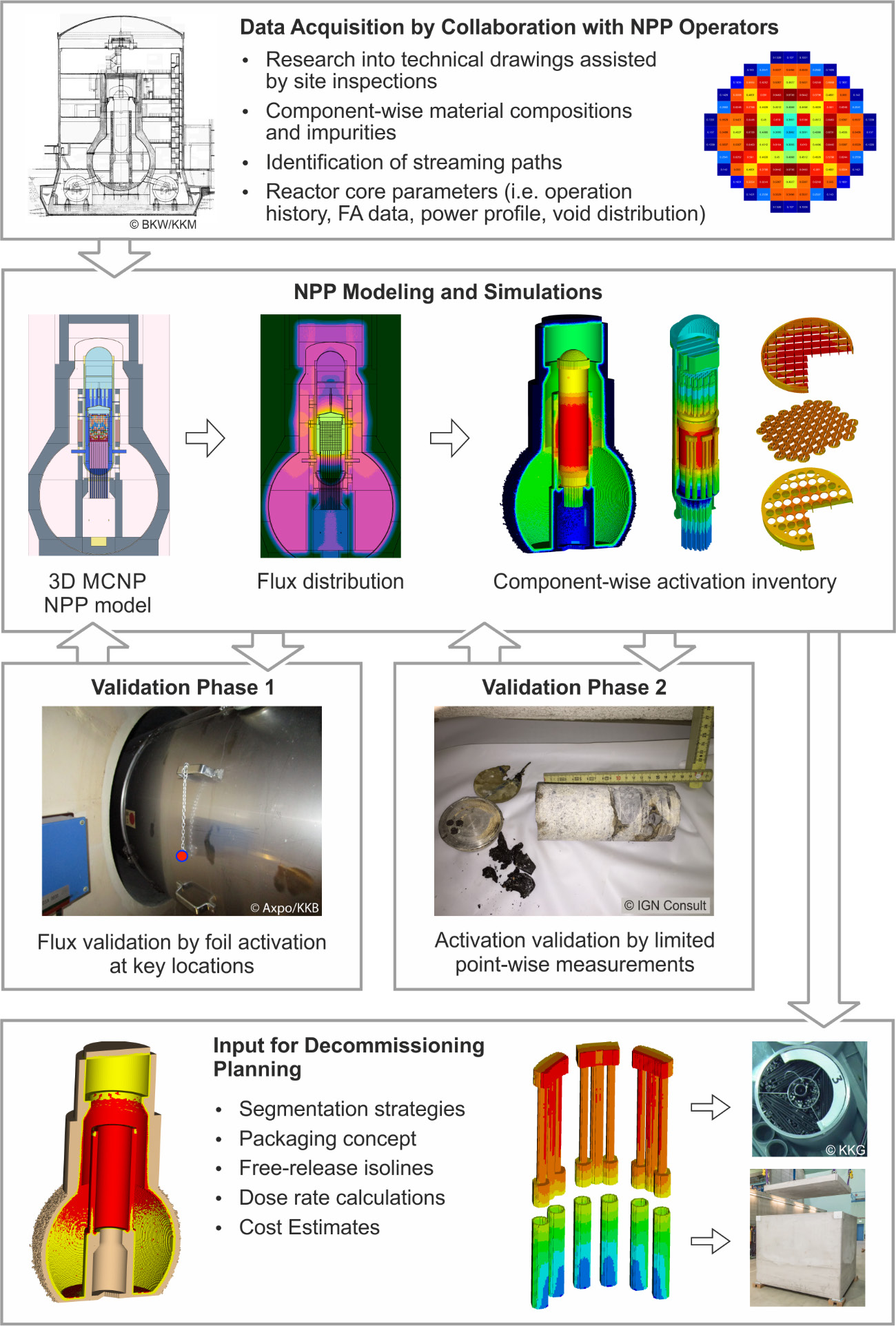Advanced Methodology for Activation Characterization (AMAC)
Nagra (2022): Advanced Methodology for Activation Characterization (AMAC). Nagra Arbeitsbericht NAB 22-19.
pdf NAB 22-19 Advanced Methodology for Activation Characterization (AMAC)(5.51 MB)
A detailed understanding of the activity distribution within the nuclear power plant (NPP) at time of shutdown is essential for the planning of the decommissioning process and the corresponding segmentation strategy, choice of waste containers, packaging concepts, and logistics considerations.
Apart from the spent fuel present on the site, the radiological condition of the site is a result of two pathways: neutron activation and contamination. With almost 1017 neutrons released per second per MW (of thermal power), despite the many layers of shielding, a fraction of them successfully leaks out of the core, and eventually the reactor pressure vessel (RPV). These neutrons then interact with the nuclei in the surrounding materials (including their impurities).
Most of the products created in these neutron reactions are radioactive. This process is referred to as neutron activation. Contamination results from direct contact with radioactive substances, generally within the primary loop.
Neutron activation is analyzed using neutron transport codes, which simulate the transport of neutrons from the core to all surrounding structures with which the neutrons interact. Contamination is generally determined through direct measurements. This report aims to provide an overview of the methodology employed by Nagra to quantify neutron activation in NPPs. Nagra regularly updates its studies for the radiological characterization of all Swiss NPPs. Such
efforts include the estimation of radioactivity in the NPP through neutron activation and radioactive contamination of structures and components within the controlled area of the reactor facility. To support these efforts, Nagra has developed an NPP activation analysis methodology, based on three-dimensional models of NPPs created for the particle transport code MCNP (Werner 2017).
The first uses of MCNP to characterize neutron activation in NPPs at Nagra (Volmert & Pantelias Garcés 2011a, Volmert & Pantelias Garcés 2011b, Volmert & Pantelias Garcés 2011c, Volmert & Pantelias Garcés 2011d) were performed in support of cost study 2011 (KS11) and MIRAM14 (Nagra 2014). The methodology was further developed in two PhD projects: the first (Pantelias Garcés 2013) focusing on the application of variance reduction to facilitate a higher level of model
complexity and the second (Bykov 2019) developing a sequence to automate the activation calculations and manage the large quantities of data that the detailed calculations produced. Following these developments, the methodology was named AMAC – Advanced Methodology for Activation Characterization. A scheme summarizing AMAC can be seen in Fig. 1-1.
AMAC is a versatile methodology, which can be applied to any nuclear reactor type and in support of different types of analyses:
- develop and optimize segmentation strategies and the associated packaging concepts for reactor internals and the RPV
- quantify the volume of activated concrete surrounding the RPV and how it changes for different disposal scenarios (e.g., after additional decay time)
- determine the activation depth of these structures to support the static investigations of the reactor building (answering whether the activated material can be safely removed while still preserving the structural integrity of the building)
- support calculations of the gamma dose rate resulting from the activation of the components and structures
- and describe the full nuclide vectors (originating from neutron activation) in all the different sections of the controlled zone

It should be noted that each of these applications has its own requirements on, for example, the target level of model detail. Typically, the ultimate goal of the AMAC model designer is to prepare an NPP model that can be used for all of these applications, or at least all that are envisioned for the NPP in question.
This report primarily aims to define AMAC as a methodology, specifying the individual steps and the software tools used. Additionally, this report details the application of AMAC in support of MIRAM (Model Inventory for Radioactive Materials) – the Nagra database of current and future waste used for long-term safety analyses of the deep geological repository. Specifically, how AMAC is used to characterize the nuclide inventories associated with MIRAM waste package
types (Abfallgebindetypen – AGT) for the general license application (Rahmenbewilligungsgesuch – RBG) version of MIRAM – MIRAM-RBG (Nagra 2023).
The structure of this report follows the individual steps of the scheme summarizing AMAC shown in Fig. 1-1. Chapter 2 describes the data acquisition process, the type of data that is collected, and the steps taken when the NPP cannot provide this data. The way this data is then used to build the MCNP models is explained in Chapter 3, with Chapter 4 discussing the types of calculations carried out. Chapter 5 explains the variance reduction techniques (as developed in (Pantelias Garcés 2013)) applied to these calculations to increase their computational efficiency. The calculation sequence for the activation calculations (as developed in (Bykov 2019)) is described in Chapter 6. The efforts undertaken to validate these MCNP models are discussed in Chapter 7. In order to deal with the large amount of results data produced by AMAC, various data management and analytics tools have been developed (AMAC Data Tools). These are documented in Chapter 8. The usage of these tools to describe a packaging concept for internals and RPV, as well as to characterize the activated sections of the surrounding structures, is explained in Chapters 9 and 10, respectively.

